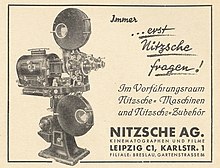Johannes Nitzsche
Johannes Nitzsche (born November 21, 1879 in Leipzig , † January 17, 1947 in Leipzig-Dosen) was a German designer and manufacturer of film projectors .
As a young technician employed in Leipzig, Johannes Nitzsche gained experience in dealing with the still new medium of cinema . In 1903 he went into business for himself and launched the Vitagraph, his first self-designed 35-millimeter film projector . Nitzsche founded a film distributor and was the leaseholder of several Leipzig cinemas. With the projectors Saxonia (1907) and Matador (1911), Nitzsche brought first-class devices onto the market, which found national and international distribution. The company expanded and moved within Leipzig in 1917 with film distribution and projector construction to Karlstrasse. In 1921 Nitzsche Apparatebau AG was founded. The economically difficult period of inflation was overcome thanks to good results in international business. Further sources of income were provided by the feature film distribution, which was initially run as a separate company, but then merged with Nitzsche Apparatebau AG to form Nitzsche AG - Kinematographen und Films. In 1926 the company got into great trouble, but managed to recover. With the establishment of Zeiss Ikon AG, Nitzsche faced very strong competition from neighboring Dresden , which was met with increased foreign activities. The company was able to grow again until 1931, the lack of payments caused problems, which were exacerbated by a collapse in foreign business.
The competitor Zeiss Ikon finally acquired Nitzsche AG in 1933. Johannes Nitzsche left the company. Projector construction - mainly the newly developed types Matador I and II - continued there until 1936, but was then given up in favor of the construction of precision mechanical equipment (gyro compasses, etc.). In 1938 Zeiss Ikon sold its shares in Nitzsche AG to the Kieler Anschütz & Co GmbH . 1945 took place expropriation of 1943 in a limited liability company converted (GmbH) plant that the VEB was affiliated medical technology. From 1935 Johannes Nitzsche repaired projectors and other cinema technology in a newly founded workshop to earn a living. He died in 1947 and his son Hans Nitzsche took over the workshop, which he continued after converting it into a production cooperative for the trade (PGH, in the 1950s) and in which the Matador 1B projector was the last type of projector to be built in small numbers until around the beginning of 1952 has been.
Products
- Vitagraph
- Saxonia IV
- Kinino
- Castor
- reform
- ZSV double machine
- Matador, II and IB
- Photo high gloss dry press (Piccolo)
literature
- Ralph Nünthel: Johannes Nitzsche. Cinematographen & Films, the history of the Leipzig cinema pioneer, his company and his technology. Sax-Verlag, Beucha 1999, ISBN 3-930076-85-3 .
- Herbert Tümmel: German motion picture projectors for 35 and 70 mm film. A catalog. Deutsche Kinemathek Foundation, Berlin 1986.
| personal data | |
|---|---|
| SURNAME | Nitzsche, Johannes |
| BRIEF DESCRIPTION | German technician and cinema pioneer |
| DATE OF BIRTH | November 21, 1879 |
| PLACE OF BIRTH | Leipzig |
| DATE OF DEATH | January 17, 1947 |
| Place of death | Leipzig |
